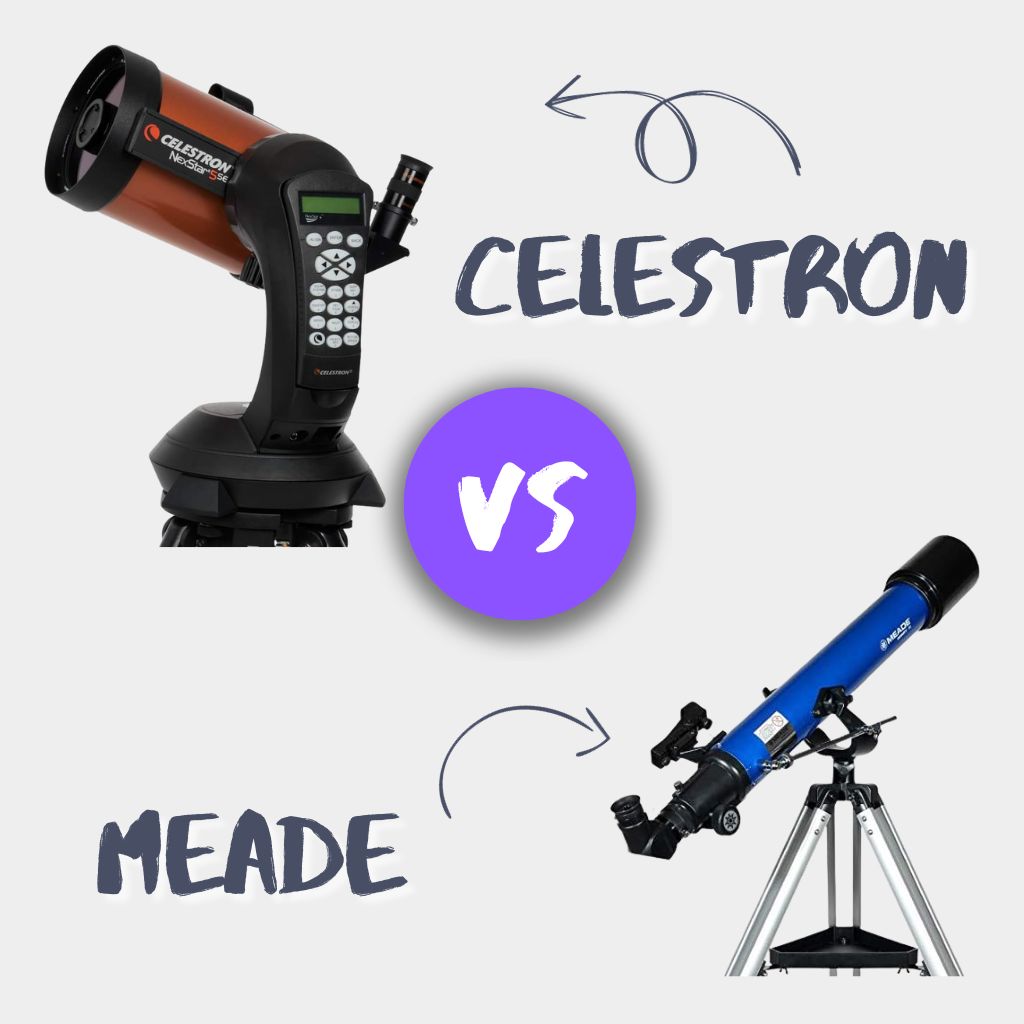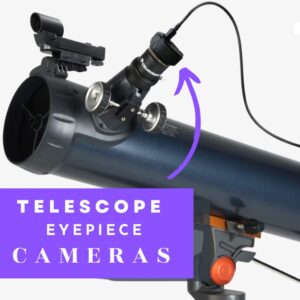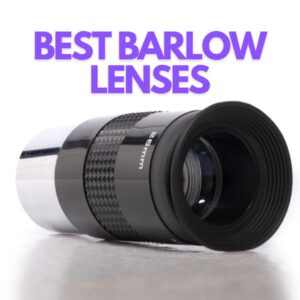This site contains affiliate links to products. I may receive a commission for purchases made through these links.
Celestron is a renowned name in the world of telescopes, known for its innovative and high-quality products. This brand offers a wide range of telescopes for amateurs and professionals, ensuring cutting-edge technology and clear, crisp imagery.
Meade, on the other hand, is another giant in the telescope industry, boasting its own line of exceptional telescopes. Meade offers a diverse range of options, allowing both beginners and seasoned astronomers to explore the cosmos in vivid detail.
Between Celestron and Meade, various differences and similarities stand out, affecting the choice of telescope for consumers. Factors like price, performance and technology are crucial in making this decision.
In their own right, each brand offers stellar options for stargazing, astronomical photography, and deep-space exploration.
Understanding the subtle and more significant differences between the two can help potential buyers make a more informed choice.
In this post, we’ll delve deeply into the Celestron and Meade telescopes. We’ll provide a detailed comparison of their features, technology, pros, and cons. We’ll also explore their key product lines, highlighting their strengths and weaknesses.
Celestron vs Meade telescopes: Quick facts
| Feature/Aspect | Celestron | Meade |
| Year of Establishment | 1964 | 1972 |
| Design | Orange tube design | Blue tube design |
| Price Range | $50 to around $9,000 | $45 to almost $20,000 |
| Manufacturing Locations | Mostly Taiwan, with centralized production | Dual-location: Taiwan and Irvine, CA |
| Observing Goals | Suited for stargazing, astrophotography, deep-sky objects, and planetary viewing | Suited for planetary observations, deep sky objects, and beginners |
| Warranty | 2-year to limited lifetime | Standard 1-year warranty |
| Key Technologies | SkyAlign technology for easy alignment | Advanced optics, high-grade optical glass |
Key differences between Meade and Celestron telescopes
There’s little difference between Meade and Celestron. Both brands stand out for their commitment to advanced technology and diverse telescope range.
Here are the few differences between these two great telescope brands:
Design aesthetics
Meade is known for its iconic blue tube design, while Celestron is known for its distinctive orange tube design. These design choices are part of the brand identity of each company.
Technology
Celestron is often associated with its advanced GoTo (computerized) telescope systems, including the popular NexStar series. These telescopes can automatically locate and track celestial objects, making them user-friendly for beginners.
Meade also offers computerized telescopes with tracking capabilities, such as the LX200 and LX600 series, which are known for their advanced features.
Price range
Meade’s telescope range stretches from $45 to almost $20,000. It includes extremely powerful telescopes, ideal for advanced astrophotography and deep space exploration.
This broad range caters to various users, from those seeking a beginner telescope to professionals needing advanced features and performance.
Celestron telescopes, priced between $50 and around $9,000, focus on offering great telescopes within a more concise price bracket.
Warranty
Meade Instruments provides a one-year warranty, ensuring basic protection and support for new telescope owners. This standard warranty underlines their commitment to customer satisfaction and product reliability.
Celestron offers a 2-year to limited lifetime warranty, a major upgrade for those investing in their telescope range.
This extended warranty period reflects their confidence in their product quality and commitment to customer support.
It makes Celestron a more assured choice for long-term investment, especially for serious enthusiasts in astrophotography and exploration.
Observing goals
Celestron telescopes, especially models equipped with GoTo technology and advanced tracking mounts, are well-suited for a wide range of astronomical observations, including stargazing, capturing images of deep-sky objects, and detailed views of planets.
Meade telescopes, including their Schmidt-Cassegrain and other models, are particularly well-suited for observing planets, such as Jupiter and Saturn, as well as deep-sky objects like galaxies and nebulae. They also offer options for beginners with user-friendly models that are easy to set up and use.
Availability
In general, Celestron telescopes are more widely available compared to Meade telescopes. This availability advantage is due to Celestron’s extensive network of retailers, global distribution, diverse product range, and strong brand recognition.
Brief overview of Celestron
Celestron is globally acknowledged for its remarkable commitment to delivering clear and vivid views of celestial bodies. The brand is synonymous with innovative technologies and a robust range of telescopes suitable for all levels of stargazers.
Is Celestron a good telescope brand?
Celestron is unquestionably a leading telescope brand. It is renowned for its advanced telescopes that bring celestial sky objects into stunning clarity.
The brand’s meticulous attention to optics and aperture design guarantees that every view of stars, planets, or other celestial bodies is as detailed and crisp as possible.
Celestron’s commitment to innovation ensures customers can access the most advanced telescopes and technologies, such as the SkyAlign technology.
This user-friendly alignment technology makes it easy for beginners to start their astronomical journeys, aligning the telescope with celestial markers for precise observations.
The company offers various models that suit every budget, from high-end telescopes for seasoned astronomers to entry-level options at a relatively low price for beginners.
Read more: Is Celestron a Good Telescope Brand?
What are the best Celestron telescope models?
Celestron has been a pioneering force in the telescope industry for decades, and its top models include:
Celestron AstroMaster 130EQ – Best for beginners
The Celestron AstroMaster 130EQ has a 130mm glass optic objective lens. This scope is designed for terrestrial and celestial viewing, ensuring users can explore the skies and the earth with equal clarity.
The robust aluminum tripod holds the telescope stably, offering clear images of Saturn, Jupiter, and the Moon.
The telescope features an AstroMaster German Equatorial manual mount, equipped with two slow-motion control knobs. This feature allows for precise adjustments and steady viewing, making it suitable for amateur and budding professional astronomers.
The AstroMaster 130EQ comes with two eyepieces, a 20mm and a 10mm, allowing 45x and 90x magnification, respectively. This feature enhances planetary viewing, offering a detailed and vibrant viewing experience.
The quick setup and no-tool requirement make it a favorable option for individuals new to stargazing.
Read also: What Can You See with Celestron AstroMaster?
Celestron NexStar 8SE – Best for deep sky objects
The Celestron NexStar 8SE houses an 8-inch primary mirror, ensuring ample light-gathering ability under dark skies. The scope delivers unmatched views of the solar system’s marvels and deep-sky objects, making it a valuable asset for professional astronomers.
The fully automated GoTo mount is a highlight of the NexStar 8SE. With a database of more than 40,000 celestial objects, the automatic tracking feature locates and tracks celestial bodies, contributing to an effortless stargazing experience.
This advanced technology complements the sleek orange tube design, combining aesthetics with functionality.
Advanced users will find the compatibility with high-tech accessories, like SkySync and StarSense AutoAlign, advantageous.
The NexStar 8SE grows with the user, evolving as their understanding and love for astronomy deepen. It stands as a reliable companion in the exploration of the cosmos.
You may also like: Are Celestron NexStar Telescopes Good?
Celestron Inspire 100AZ Refractor-Best for astrophotography
The Celestron Inspire 100AZ Refractor hosts the largest aperture in the Inspire family line. It has a short tube that broadens the field of view for capturing larger, fainter, deep-sky objects.
The built-in smartphone adapter in the main telescope lens cap is perfect for capturing high-power images, proving its worth in astrophotography.
The innovative design of the Inspire 100AZ enhances its utility and appeal. The asymmetrical mount design guarantees lightweight and incredible stability, ensuring clear and stable images.
The erect image optics enrich the viewing experience, enabling easy and precise viewing day and night.
An integrated red LED flashlight in the mount head illuminates the accessory tray, or you can remove it for use as a spotlight. This addition enhances convenience, ensuring users have light where they need it most.
The Inspire 100AZ’s ease of setup distinguishes it further as a reliable telescope for novice to intermediate astronomers. The quick-release dovetail mount aids in effortless assembly, allowing more time for exploring and enjoying the night skies.
Brief overview of Meade
Meade is a notable brand that offers an extensive array of options, from beginner scopes to advanced Schmidt-Cassegrain telescopes, satisfying the needs of a diverse array of astronomers.
Is Meade a good telescope brand?
Meade indeed holds a prestigious place among telescope brands. The clarity and precision in viewing celestial wonders are unmatched, thanks to the state-of-the-art technology Meade offers in their telescope lineup.
The brand is committed to aligning every telescope with cutting-edge advancements for optimal exploration of the cosmos.
The superb build quality of Meade’s telescopes is a hallmark of the brand’s dedication to reliability and performance.
This ensures every telescope, from the simplest model to the advanced Schmidt Cassegrain telescope, stands the test of time, offering enduring exploration of celestial wonders.
One of the best features of Meade’s offerings lies in its affordability. The diverse range Meade offers ensures that more individuals can delve into astronomy without breaking the bank.
This approach maintains the balance between cost and quality, presenting budget-friendly models that do not compromise on performance and clarity.
What are the best Meade telescope Models?
Delve into the depths of the cosmos with precision and clarity; the best Meade telescope models include:
Meade Instruments Polaris 114mm telescope – Best for planets
Meade’s Polaris 114mm Aperture telescope features a notable 114mm aperture and 1000mm focal length, promising detailed and sharp images of the planets. This makes it an excellent choice for exploring brighter planetary nebulae.
The German equatorial mount with slow-motion controls enables seamless tracking of celestial objects across the night sky.
The Polaris 114 encompasses a rack-and-pinion focuser, setting circles, and latitude control, providing enhanced operational convenience.
These features contribute to smooth adjustments and precise control, essential for any amateur astronomer seeking high-quality images. The telescope’s robust construction and advanced features solidify its place for dedicated planetary observations.
The telescope’s package includes three diverse eyepieces and a 2x Barlow lens. This broadens viewing options and ensures adaptability to various observational scenarios.
The red dot viewfinder streamlines the process of targeting specific celestial objects, enhancing the overall stargazing experience.
Meade Infinity 50 – Best for beginners
Meade Infinity 50 is a good first telescope for novices with a 50mm aperture and 600mm focal length. It guarantees sharp images, while the altazimuth mount enhances ease of use, making it an optimal travel telescope.
This model boasts three eyepieces and a 2x Barlow lens, optimizing its magnification capabilities for a diverse range of celestial viewing. The 5×24 optical viewfinder aids in swift and accurate object location, enhancing the overall observational experience.
The Infinity 50 promotes expansive celestial and terrestrial exploration, making it a versatile choice for new astronomers. Its comprehensive features stimulate a growing interest in celestial observations, making it stand out among other telescopes.
The ease of use and multifunctionality mark the Infinity 50 as a reliable ally for those beginning their cosmic journey.
The provision of astronomical software and an instructional DVD proves invaluable, offering guidance and insight to users. The practicality and affordability of the Infinity 50 solidify its status as a top choice for amateur astronomers.
Meade Instruments LX85 – Best for deep sky objects
The Meade Instruments LX85 is a superior choice for delving into deep-sky objects. It offers a large aperture of 115mm and an 805mm focal length.
This combination, along with high-grade FPL 53 ED optical glass, provides ultra-high transmission coatings for extraordinary color correction and contrast.
These specifications make it ideal for viewing star clusters and other deep-sky objects, ensuring sharp and high-quality images.
The LX85’s vixen-style dovetail receiver, capable of mounting equipment up to 33 lbs, and low-cog servo motors ensure stability and smooth tracking performance. This feature proves crucial for unyielding image quality while observing celestial objects.
It features Meade’s AudioStar Hand Controller, which offers a rich educational experience.
This feature includes audio files and an internal speaker that provides multiple guided tours and digital positional readouts, perfect for individuals eager to delve deeper into the cosmos.
The controller amplifies the educational aspect of the LX85, making it a suitable choice for both professional and amateur astronomers.
An aluminum hard carry case and a DC power cord round off the offering, ensuring users have everything needed for an in-depth astronomical exploration.
You may also like: Meade Telescopes (All Models Compared)
Celestron vs Meade telescopes, which is better?
Choosing between Celestron and Meade telescopes ultimately depends on individual requirements and preferences.
Both companies offer a range of high-quality telescopes with advanced features suited for beginners and more experienced astronomers.
Celestron is often lauded for its user-friendly and innovative designs. At the same time, Meade is known for its robust and high-performing telescopes, making the decision a matter of specific needs and priorities.
Takeaway: Discover the differences between Celestron and Meade telescopes to find your ideal celestial companion
Both Meade and Celestron telescopes stand tall in astronomy, each offering stellar features, innovation, and performance.
Your pursuit for clarity, ease of use, and reliability in observing the boundless night sky will guide your choice.
Embark on your cosmic journey with assurance, knowing the universe is waiting patiently for your gaze, whether through a Celestron or a Meade telescope.
You may also like:









